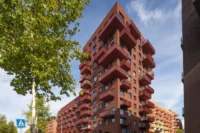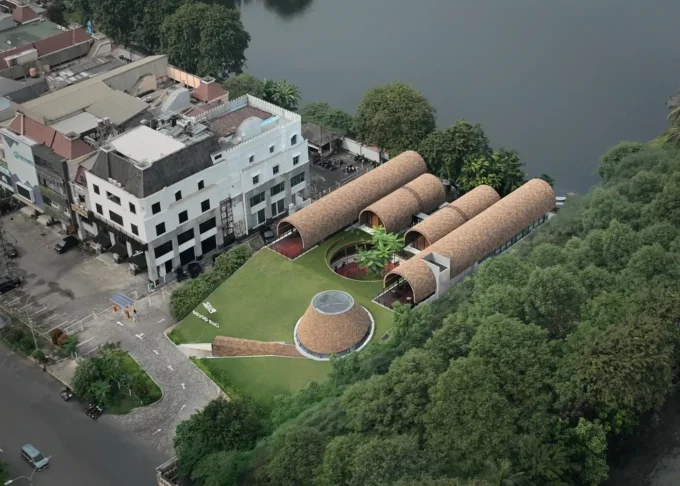Located on the lush grounds of Dempsey Hill in Singapore, the AIR Circular Campus and Cooking Club redefines the concept of fine dining. Designed by OMA in collaboration with Zarch Collaboratives, the project moves away from the traditional, exclusive, and passive consumption model of haute cuisine. Instead, it transforms dining into an active and shared journey—one that encourages guests to engage deeply with food, the environment, and the values of responsible sourcing, waste reduction, and culinary education.

Context and Site Heritage
Dempsey Hill, now a vibrant art and lifestyle district, carries a layered history. In the mid-19th century, the area was a nutmeg plantation. From the 1860s to the 1990s, it served as a British military barracks and later as a civil service club. At the heart of the AIR campus sits the CSC Dempsey Clubhouse, a modernist structure from the 1970s originally built for leisure and sports activities.
While the clubhouse itself holds no formal heritage designation, the surrounding natural environment is strictly protected. Local regulations require the conservation of all trees with girths exceeding one meter. This contrast—between the freedom to transform the building and the obligation to preserve the landscape—inspired the architects to question conventional notions of preservation. Could both the valued natural elements and the seemingly ordinary building be reimagined as equally important contributors to the site’s identity? Their approach sought to make minimal but meaningful architectural changes, reducing construction waste while celebrating the coexistence of nature and built form.
A New Arrival Sequence
One of the most significant interventions is the creation of a 100-meter walkway connecting a main parking area to the clubhouse. This new footpath replaces a narrow, hidden route that previously made the site feel inaccessible. Organic in form, the walkway meanders through the terrain, subtly shaping the expansive green space into two distinct zones: a cultivated garden on one side and an open lawn on the other.
Visitors arriving via this path have multiple options: enter directly into the clubhouse, wander into the farm garden—where they can see how ingredients are grown and even taste seasonal produce—or stroll toward the lawn, which hosts picnics, gatherings, and events. Along the walkway, small patios serve as resting points, offering shaded seating that complements the openness of the lawn.

Transforming the Clubhouse
The existing double-storey clubhouse, defined by its ribbon windows, has been adapted for AIR’s program. On the ground floor, the new walkway extends indoors, functioning as a spine that organizes circulation. The main dining area now faces the lawn, with an operable front façade that can open entirely, transforming the formerly enclosed interior into a semi-outdoor space. Terraces extend dining toward the lawn, encouraging a relaxed, communal atmosphere. Behind the dining area, an open kitchen allows guests to witness the preparation process, making the act of cooking transparent and integral to the dining experience.
The upper level is more intimate, with full-height glazing replacing the original façade to create panoramic views over the lawn. Here, guests find a quieter dining space as well as a research area for culinary experimentation, particularly focused on innovative ingredient use. At the rear, a cooking school invites guests to participate in workshops, sharing skills and knowledge about farm-to-table practices.
The Cylinder and Sustainable Details
A bold new cylindrical volume inserted at the rear consolidates key operational functions—guest and staff staircases, a bar, kitchen facilities, and a machine room. Its placement away from the main façade respects the clubhouse’s original geometry while clearly signaling the integration of contemporary elements.
Sustainability is embedded throughout the design. All furniture and fixtures, crafted by designer Andreu Carulla, use recycled materials such as timber, plastic bottles (HDPE) from a past art installation, and repurposed Styrofoam, commonly associated with disposable food containers. These details reinforce AIR’s ethos of uncovering potential and beauty in what is often dismissed as waste.

A New Dining Culture
AIR Circular Campus is not just a restaurant—it is a culinary ecosystem. The site simultaneously hosts farming, foraging, cooking, learning, and eating. Guests might start their journey by harvesting herbs in the garden, then join a cooking class, dine on the lawn, and end the evening in the semi-open dining hall. This multiplicity of experiences encourages guests to become active participants rather than passive consumers.
By dissolving the boundaries between kitchen, table, and landscape, the project fosters a new, informal fine-dining culture—one where pleasure is intertwined with awareness, creativity, and connection to place. The result is a living, evolving campus that challenges the conventions of luxury dining and transforms it into an immersive, community-driven practice.
Photography: Frans Parthesius
- Adaptive reuse of clubhouse
- AIR Circular Campus Singapore
- Circular economy in architecture
- Community-driven dining space
- Contemporary additions to modernist building
- Culinary education architecture
- Culinary research facilities design
- Dempsey Hill architecture project
- Farm-to-table restaurant design
- Garden-to-plate experience
- Immersive dining architecture
- Landscape preservation in architecture
- OMA architecture Singapore
- Organic walkway design
- Outdoor and indoor dining integration
- Recycled material furniture design
- Semi-open restaurant space
- Sustainable fine dining design
- Transparent kitchen design
- Zarch Collaboratives design
























































Leave a comment